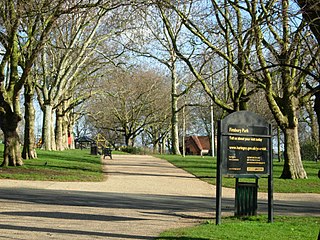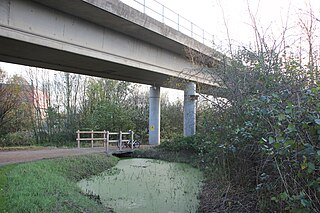
Finsbury Park is a public park in Harringay, north London, England. The park lies on the southern-most edge of the London Borough of Haringey. It is in the area formerly covered by the historic parish of Hornsey, succeeded by the Municipal Borough of Hornsey. It was one of the first of the great London parks laid out in the Victorian era. The park borders the neighbourhoods of Finsbury Park, Stroud Green, and Manor House.
RHS Britain in Bloom is the largest horticultural campaign in the United Kingdom. It was first held in 1963, initiated by the British Tourist Board based on the example set by Fleurissement de France, which since 1959 has promoted the annual Concours des villes et villages fleuris. It has been organised by the Royal Horticultural Society (RHS) since 2002.

Keep Britain Tidy is a UK-based independent environmental charity. The organisation campaigns to reduce litter, improve local places and prevent waste. It has offices in Wigan and London.
Natural England is a non-departmental public body in the United Kingdom sponsored by the Department for Environment, Food and Rural Affairs. It is responsible for ensuring that England's natural environment, including its land, flora and fauna, freshwater and marine environments, geology and soils, are protected and improved. It also has a responsibility to help people enjoy, understand and access the natural environment.
The London Borough of Haringey maintains 240 hectares of parks and open spaces. By 2015, 20 of these were accredited with a Green Flag Award. Until their disbandment in April 2009, the parks were patrolled by the Haringey Parks Constabulary.

Berthold Romanovich Lubetkin was a Georgian-British architect who pioneered modernist design in Britain in the 1930s. His work includes the Highpoint housing complex, the Penguin Pool at London Zoo, Finsbury Health Centre and Spa Green Estate.

Beechwood Park is a thirty-acre public park situated in the eastern Beechwood area of the city of Newport, South Wales. The park is listed on the Cadw/ICOMOS Register of Parks and Gardens of Special Historic Interest in Wales.
The Code for Sustainable Homes was an environmental assessment method for rating and certifying the performance of new homes in United Kingdom. First introduced in 2006, it is a national standard for use in the design and construction of new homes with a view to encouraging continuous improvement in sustainable home building. In 2015 the Government in England withdrew it, consolidating some standards into Building Regulations.

The Security Industry Authority (SIA) is the statutory organisation responsible for regulating the private security industry in the UK. Established as a non-departmental public body in 2003, the SIA reports to the Home Secretary under the terms of the Private Security Industry Act 2001 (c. 12).

Bow Creek Ecology Park is a small open space along Bow Creek tidal estuary of the River Lea in Canning Town in Newham, in east London. It is operated by the regional Lee Valley Park system.
Moss Bank Park is a 34.25 hectares park in Bolton, Greater Manchester, England. It consists of open space, woodland, gardens and other facilities. Moss Bank Park has been awarded the Green Flag Standard in 2008 and 2009. The Green Flag Scheme is a national standard for public parks and green spaces that aims to raise standards across the UK. This award puts Moss Bank Park alongside Brighton Pier, London Zoo, Alton Towers and the Norfolk Broads.
Building for Life, Building for Life 12, Adeliladu am Oes 12 Cymru and Building for a Healthy Life are design tools for improving the quality of new homes and neighbourhoods used across England and Wales. The current version in use in England is Building for a Healthy Life .

The Big Tree Plant was a Government-sponsored campaign in England in 2010, to promote the planting of trees in neighbourhoods where people lived and worked. The national campaign ran over four years from 2011 to 2015 and met its objective to plant one million trees.

Martineau Gardens is a community garden on Priory Road in Edgbaston, Birmingham, England. It adjoins the Priory Hospital on Bristol Road. It features over two acres of woodland and formal gardens. The Gardens are administered by a registered charity and are a member of the Federation of City Farms and Community Gardens.
Keep Wales Tidy is a Welsh national voluntary environmental charity which works towards achieving "a clean, safe and tidy Wales". It works in partnership with Local Authorities, schools and community groups, and organisations such as Waste Awareness Wales and Environment Wales in order to achieve these goals.

Stonebridge City Farm is an urban farm in St Ann's, Nottingham, England. Created in 1980, it is relatively small in size, being sited in an area of regeneration, on the footprint of a school and grounds that were originally planned to have been built there.
Neighbourhoods Green is an English partnership initiative which works with social landlords and housing associations to highlight the importance of open and green space for residents and raise the overall quality of design and management with these groups.

The Inch is a district of Edinburgh, Scotland, located to the south of Inch Park in the south of the city. It is located 2 miles (3 km) south south-east of central Edinburgh. It incorporates the Inch housing development, Inch Park and the category A listed Inch House, a former country house now used as a community centre. The associated Inch Doocot or dovecot, also a category A listed building, is situated close by, west of Gilmerton Road.
Keep Scotland Beautiful is an environmental charity based in Scotland, which aims “to make Scotland a cleaner, greener and more sustainable place to live, work and visit.” The organisation campaigns and educates on a range of environmental issues including climate change and litter reduction.

Northbrook Park is a public park located on Baring Road south of Lee Green and north of Grove Park in the London Borough of Lewisham, southeast London, England. It is roughly 9 acres (3.6 ha) in size, and contains a large central field bounded by trees, a children's playground, with a sandpit and splash pool, a multipurpose game court, two football pitches, and outdoor gym equipment. The park was previously a field named Ten-Acre Field, despite actually being 7 acres (2.8 ha), and part of the Baring Estate of Lee. In 1898, Thomas Baring, 1st Earl of Northbrook gifted part of his family's estate to public use in commemoration of the Diamond Jubilee of Queen Victoria. The Park was designed by Lt Col J J Sexby, Chief Officer of the London County Council's Parks Department, then was officially opened on 14 March 1903. In the past the park contained a larger playground, a paddling pool, a "legal" graffiti wall, a pond, a bowling green and a tennis court.
















